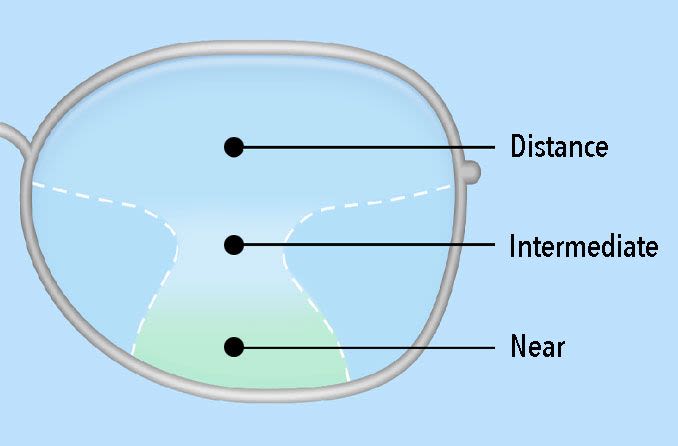Progressive (multifocal) lenses for a younger you

If you're over age 40 and struggling to see small print even with your current glasses, you may find progressive lenses will help.
That doesn't mean you have to wear ugly bifocals or trifocals. For most people progressive lenses are a much better option.
What are progressive lenses?
Progressive lenses are multifocal spectacle lenses that look exactly the same as single vision lenses but they will help you see clearly at all distances without those annoying (and age-defining) "bifocal lines" that are visible in old fashioned bifocals and trifocals.

The power of progressive lenses changes gradually from point to point on the lens surface, providing the correct lens power for seeing objects clearly at any distance.
Bifocals, on the other hand, have only two lens powers — one for seeing distant objects clearly and a second power in the lower half of the lens for seeing clearly at a specified reading distance. The junction between these distinctly different power zones is defined by a visible "bifocal line" that cuts across the lens.
Progressive lenses also provide clear distance and near vision but don't have the visible bifocal line, as they allow you to see at virtually all distance their design is significantly more advanced than bifocals or trifocals.
Premium progressive lenses usually provide the best comfort and performance and there are many brands to choose from. Your eye care professional can discuss with you the features and benefits of the latest progressive lenses and help you find the best lenses for your specific needs.
Progressive lens benefits
Most people start needing spectacles sometime after age 40. This is when a normal aging change in the eye called presbyopia reduces our ability to see clearly up close.
For anyone with presbyopia, progressive lenses have significant visual and cosmetic benefits compared with traditional bifocals and trifocals.
As already mentioned, bifocals have just two powers — one (in the top half of the lens) for distance vision, and a second (in the lower half of the lens) for near vision. Basically, the zone for near vision is the combination of the lens prescription for distance vision plus an 'added' amount of power to overcome your presbyopia and help you see small print and near objects more clearly.
This additional power is called the near "add" of the prescription. Typically it's the power required to enable you to see clearly at a normal reading distance of about 40cm from your eyes.
Trifocals go one step further — they have a third power for seeing objects clearly at arm's length. This "intermediate" power of a trifocal lens is located in a thin horizontal zone between the distance and near power zones.
Progressive lenses, on the other hand, have an infinite change of power in a gradual change in power from point to point up and down the surface of the lens.
The design of progressive lenses offers these important benefits:
It provides clear vision at all distances (rather than at just two or three distinct viewing distances). They don't restrict the range of visual activities you can undertake.
It eliminates bothersome "image jump" caused by bifocals and trifocals. This is where objects abruptly change in clarity and apparent position when your eyes move across the visible lines in these lenses. This can increase the risk of falls for older wearers.
Because there are no "bifocal lines" in progressive lenses, they give you a more youthful appearance than bifocals or trifocals. (This reason alone may be why more people today wear progressive lenses than bifocal and trifocals combined.)
Progressive lenses don't require changes in posture in order to cover your visual needs. Bifocal wearers can often be seen craning their neck in order to try and find a point of focus.
Today's premium progressive lenses are very comfortable to wear. This is especially true of modern "free-form" progressive lenses made with digital design and production techniques.
Your optometrist can help you select the best progressive lens brand and design for your spectacle prescription and your unique visual needs.
Best uses
Progressive lenses are the lens of choice for virtually anyone who needs corrective lenses to see distant objects clearly (due to shortsightedness, longsightedness and/or astigmatism) and also has become presbyopic.
In particular, modern progressive lenses are preferred for anyone who wants the latest technology in vision correction and wants the best looking spectacles possible with no old-fashioned lines in the lenses.
There are many brands of progressive lenses, and most brands have several different designs for specific wearer needs. Seek the services of a knowledgeable optometrist to be custom-fitted with progressive lenses that best suit your needs.
Your optometrist also can give you helpful tips on how to quickly learn how to use your new progressive lenses and how to care for your spectacles to continue seeing clearly and to protect your investment.
Also, for the best clarity, comfort and protection in all lighting, ask your optometrist about adding anti-reflection coating and photochromic lenses to your new progressive lenses.
Ready to start seeing better? It starts with an eye test to get or update your prescription. Find an optometrist near you and book an eye test today.
Page published on Tuesday, 17 March 2020







